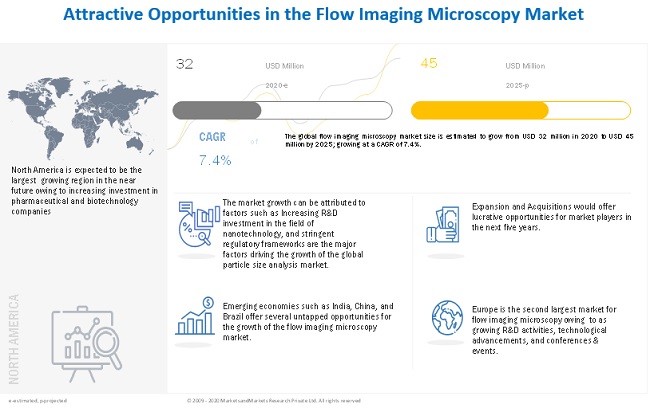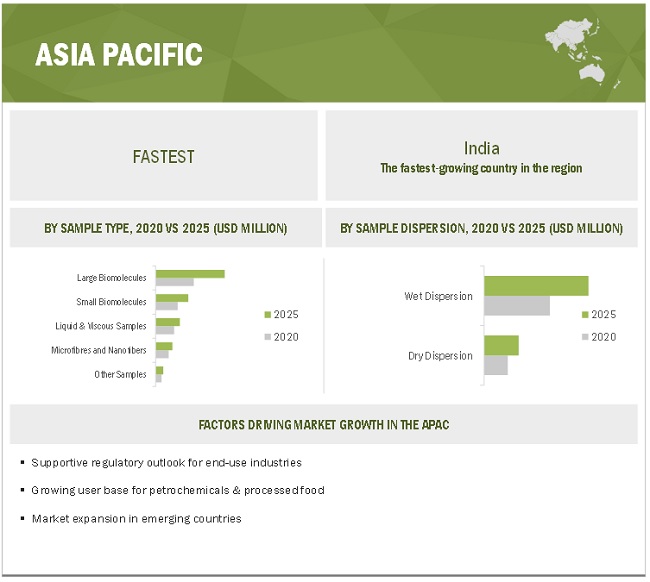Trends
Flow imaging microscopy/dynamic image analysis market
The global flow imaging microscopy market size is projected to grow from an estimated USD 32 million in 2020 to USD 45 million by 2025, at a CAGR of 7.4% during the forecast period. Market growth is driven largely by factors such as increasing research activities in the field of nanotechnology, growing investments in pharmaceutical R&D, and stringent regulatory guidelines for product quality across industries. However, the technological limitation is the major factors that are expected to restrain the growth of this market during the forecast period.

COVID-19 impact on the market
The novel coronavirus has impacted multiple industries across various sectors. It is evident that overall growth across sectors would be heavily impacted, especially in regions where the virus has a higher incidence rate, such as the US, Europe, and China. Industries such as oil and petroleum, mining, and aeronautics are the most severely impacted, while the pharmaceutical, biotechnology, and healthcare industries are optimizing this situation in order to reach and serve a maximum number of patients and healthcare professionals. Thus, impacting long term market flow imaging microscopy.
Market dynamics
Driver: Increased investments in pharmaceutical
Pharmaceutical and biotechnology companies are making significant investments in research to meet the growing needs of the healthcare sector. For instance, According to 2019 Pharmaceutical Research and Manufacturers of America (PhRMA) member annual survey, in 2018 its member companies invested a USD 79.6 billion in research and development (R&D).Moreover, collaborations between pharma companies and healthcare stakeholders for R&D into therapeutics will also stimulate the use of lab automation., hence exceeding the production levels this will likely to drive the demand of flow imaging microscopy market.
Restraints: Technological limitations
The major drawback of flow imaging microscopy is that particle size is limited to the flow cell depth. Thus, only particles within a certain range can be characterized using single magnification/flow cell depth combination. This could pose bottlenecks in processes wherein samples contain varying sizes of particles, thereby affecting the process as a whole. Such limitations of flow imaging microscopy can be expected to affect market growth during the forecast period.
Opportunities: Growing opportunities in emerging countries
Emerging markets are expected to offer significant growth opportunities to flow imaging microscopy product manufacturers and distributors during the forecast period. This can be attributed to the growing number of research activities in the field of nanotechnology, increasing R&D initiatives, and the rising focus of key market players in this region. Market growth across emerging countries is further supported by improvements in healthcare infrastructures, growing healthcare expenditure, and the availability of flow imaging microscopy manufacturers. This offer a lucrative opportunity for flow imaging microscopy.
Challenges: Lack of well-established distribution networks among SMEs
There are several small and medium-sized organizations offering niche technologies. SMEs, in particular, are facing issues in the marketing and distribution of instruments owing to budgetary constraints. This may adversely affect their revenues and survival in the market. This create an challenge flow imaging microscopy.
By sample type, the large bomolecule segment is expected to grow at the highest rate during the forecast period
Based on technology, the flow imaging microscopy market is segmented into large biomolecules, small biomolecules, microfibers and nanofibers, liquid & viscous samples, and other samples. The large biomolecules segment is expected to register the highest growth over the forecast period. The significant growth of this segment is attributed to the regulatory recommendations to analyze subvisible. In addition, company offering dynamic image analysis which can measure a wide range of particles are expected to drive the market growth of this segment.
By sample dispersion, the wet dispersion segment was the largest contributor to the imaging technologies market in 2019
Based on sample dispersion, the market is segmented into two major types—wet dispersion and dry dispersion. Factors such as increasing use of nanotechnology in the food & beverage industry, rising applications of nanoparticles, and increasing research & development activities in the pharma & biotechnology industries are driving the growth of the wet dispersion segment.
The biotechnology companies segment was the largest contributor to the flow imaging microscopy market in 2019
The biotechnology companies segment accounted for the largest share of the flow imaging microscopy market, by end user, in 2019. Factors such as the development of novel therapies to address unmet needs, increased access to medicines, and government initiatives to support biotechnology research in emerging regions have also supported market growth in this end-user segment during the forecast period. Moreover, particle analysis of biologics during formulation development and manufacturing is performed in the biotechnology industry.
Asia Pacific is expected to grow at the highest CAGR in the flow imaging microscopy market during the forecast period
The Asia Pacific is a major revenue-generating region in the flow imaging microscopy industry. Factors such as increasing awareness of nanotechnology, implementation of government reforms & regulations to improve product quality, high quality in industry standards, and the gradual movement of manufacturing activities and pharmaceutical R&D from developed markets to Asian markets are propelling the growth of the APAC flow imaging microscopy market.

Key players
The major players in the flow imaging microscopy market include Bio-Techne (US), Yokogawa Electric Corporation (Japan), MICROTRAC MRB (Germany), Micromeritics Instrument Corporation (US), FRITSCH (Germany). – MarketsandMarkets












